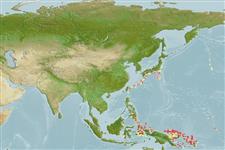Malacostraca |
Decapoda |
Glyphocrangonidae
Environment: milieu / climate zone / depth range / distribution range
Ecology
Benthic; depth range 1036 - 1138 m (Ref. 8139). Tropical
Western Central Pacific: Solomon Islands.
Length at first maturity / Size / Weight / Age
Maturity: Lm ? range ? - ? cm Max length : 1.3 cm CL male/unsexed; (Ref. 8139); 1.59 cm CL (female)
Life cycle and mating behavior
Maturity | Reproduction | Spawning | Eggs | Fecundity | Larvae
Members of the order Decapoda are mostly gonochoric. Mating behavior: Precopulatory courtship ritual is common (through olfactory and tactile cues); usually indirect sperm transfer.
Komai, T. 2006 Revision of the Glyphocrangon caeca species group (Crustacea, Decapoda, Glyphocrangonidae). p. 243-264. In B. Richer de Forges and J.-L. Justine (eds) Tropical deep-sea benthos. Mémoires du Muséum national d'Histoire naturelle 24(193). (Ref. 8139)
IUCN Red List Status
(Ref. 130435: Version 2025-1)
CITES status (Ref. 108899)
Not Evaluated
Not Evaluated
Threat to humans
Harmless
Human uses
| FishSource |
Tools
More information
Trophic EcologyFood items (preys)
Diet composition
Food consumption
Predators
Population dynamicsGrowth
Max. ages / sizes
Length-weight rel.
Length-length rel.
Length-frequencies
Mass conversion
Abundance
Life cycleReproductionMaturityFecunditySpawningEggsEgg developmentLarvae PhysiologyOxygen consumption
Human RelatedStamps, coins, misc.
Internet sources
Estimates based on models
Fishing Vulnerability
Low vulnerability (10 of 100).
